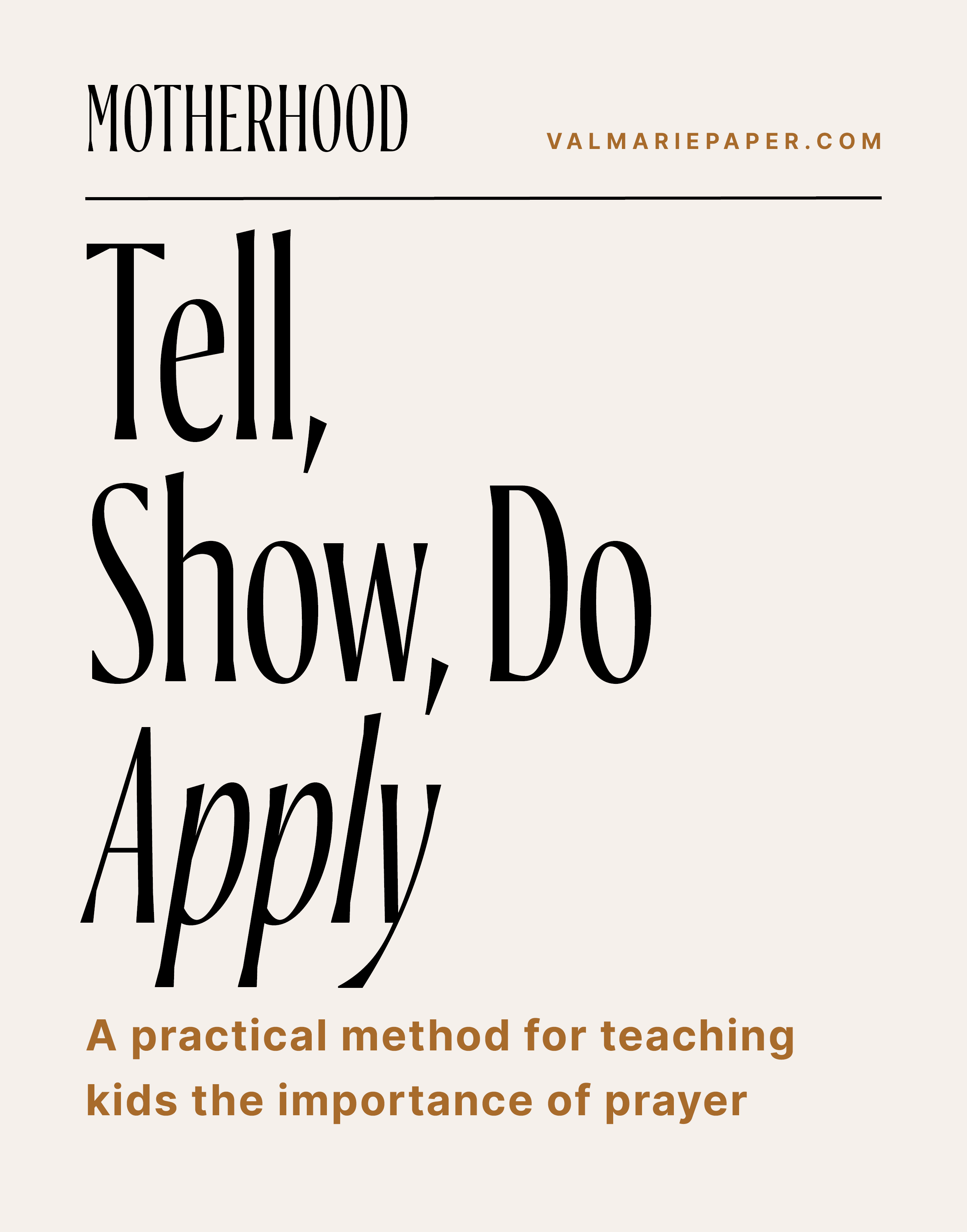 One of the most common questions I get about prayer is about how to teach our kids to pray. It can feel very overwhelming to teach our kids something we’re in the process of learning too. I’ve written a really extensive post with tips on how to teach kids to pray that includes tons of specific questions (you can find that here) but today, I wanted to share a method that just came to mind that may help.
One of the most common questions I get about prayer is about how to teach our kids to pray. It can feel very overwhelming to teach our kids something we’re in the process of learning too. I’ve written a really extensive post with tips on how to teach kids to pray that includes tons of specific questions (you can find that here) but today, I wanted to share a method that just came to mind that may help.
I started thinking just really practically about the methods teachers incorporate to teach students. Those few months trying to teach my daughter math when we were home because of Covid gave me a new appreciation for all that goes into teaching. It’s not simply telling someone how to do something. I started thinking about the methods of showing and telling for teaching and in my search, I found the Tell / Show / Do / Apply method. (You’ll see quotes throughout this blog post from this article on the method).
This is not something I’ve implemented yet, but as I thought about the framework of teaching our kids to pray, these four simple steps helped me think about how to practically do this in our everyday lives.
Teaching our kids prayer is one of the greatest things we can do, but in our busy world the more urgent priorities can take over. I hope this simple method can help you visualize how prayer can flow through your everyday moments and give you confidence to teach your kids how to pray.
TELL
In the first part, the goal is “to provide the learner with key information related to their learning”. This normally looks like “facts, concepts, rules, and procedures.” For prayer, this looks like laying a foundation of prayer. You could start with the basics like, “Who? What? When? Where? Why? How?”. You could also take a chapter of Pray Confidently and Consistently and distill it down to the very basics that a child would understand, go through the following steps and then begin again.
Start here: What do you want to teach your kids about prayer? (Ex: 6 Characteristics of God that affect how we pray [chapter 1 of Pray Confidently and Consistently], 3 important aspects of how to come to God in prayer [chapter 2], Why we pray to God)
SHOW
In this part, you will give examples of what you are trying to teach them. This helps your child “see how the information you told them is applied.” For prayer, this looks like praying in your kids’ presence after you introduce the concept to them. It can also look like giving examples like “When we sin, what would we want to say to God?” For older kids, it could also look like reading a Psalm and recognizing how David prayed or incorporating other written prayers (like Springboard Prayers).
This is such an important step because it’s often easy to tell our kids how to pray and not model it. We don’t want them to simply copy our words, right? Showing them how to pray can look like us going to God when we have moments of frustration. It can even look like times of confession when we yell or respond poorly to our child. As we model how to go to God, we give our children an example so they know what those concepts we shared in the Telling stage actually look like in everyday life.
Start here: In what moments can you model these lessons with your kids? (Ex: Read Psalm 18 together / Let them see you pray for something in your own life)
DO
In this part, you “provide your learners with the opportunity to Do what you have taught them”. With prayer, this looks like asking our kids to pray often. Don’t force it if they say no but offer them opportunities. You can do this at different times or in different circumstances. They might not know how to pray for dinner with all eyes on them but they might feel comfortable praying when a friend is hurt or they see an ambulance going down the road.
If this feels really tough to do, thinking of different opportunities to pray will get easier as prayer is a more natural part of our own days. Don’t beat yourself up here. This is one reason we share so much content on prayer and now have a book and podcast. Studying and being reminded of prayer on a regular basis helps us keep it top of mind throughout our day. (If you haven’t checked out our podcast yet, Prayer in a Noisy World, we drop 3 episodes a week on a specific topic including an interview on Mondays, How To on Wednesdays, and a Guided Prayer on Fridays. These can be helpful prompts to keep prayer top of mind!)
One important aspect of Doing that the education model emphasizes is giving feedback. I don’t think this looks like giving our kids a grade after they pray but it may mean taking time not immediately following the prayer to share thoughts in a positive way. If they are super wiggly and start playing with toys in the middle of a prayer, it might be a teachable moment of talking about God as king and the reverence we want to show Him as we pray.
Start here: In what moments can you give your kids opportunities to pray? (Ex: Mealtime, when they do something foolish, or when God does something cool)
APPLY
I love how the education model includes “apply”. It’s essentially a chance to help “learners plan out how they will apply their knowledge in their own environments.” In prayer, this might look like talking about what it would look like to pray in the future.
It could be as simple as saying “Do you know you can pray when you are afraid? You can ask God to help you because He said in the Bible that we should come to Him when we are afraid.” Then in the future, when these moments come up, our kids may be the ones to remind us to pray! I’ve seen this in my own life with my daughters. I mentioned one time praying when we see an ambulance and they’ve reminded me of this often. If you have our Springboard Prayers book, the section on emotions or circumstances could be great examples of where to start!
Start here: What future moments can you suggest as times to pray? (Ex: When you are afraid / When someone hurts your feelings / When you aren’t sure what to do / When you want to get angry.)
Let’s help each other get really practical with this! Leave a comment with any ideas for the “start here” questions that come to mind!!




Leave a Reply
Comments (0)